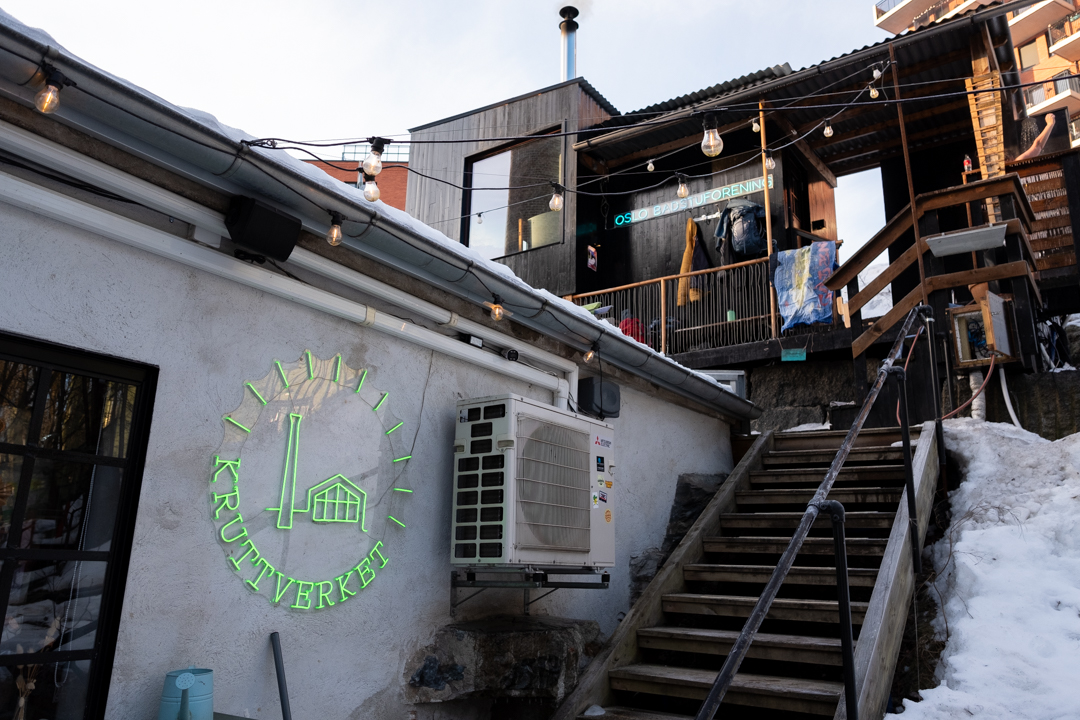Imagine a forest. Then a river, meandering through it with a steady stream throughout the year. Sitting on a gentle slope high on the riverbank is a three-storey red-brick building, its middle floor home to a café and bar, with its chimney rising above the trees. Better still—a few steps further up the slope, there’s a sauna, large enough to seat 14 people at once. Through the sauna’s wide window, you can watch snowflakes drift in the still winter air, and in summer, the gentle breeze ripple through the lush green leaves. This is Kruttverket.
Kroloftet, the neighbouring art workshop


Charming as Kruttverket (meaning “gunpowder factory” in Norwegian) may sound, it’s surprising to learn that the building housing it had been abandoned for almost 20 years before being restored in 2021. The organisation behind Kruttverket is Kroloftet, founded by scenographer Frans Friis and furniture designer Oscar Honeyman-Novotny in 2014.
Kroloftet can be roughly understood as an artist organisation and creative community, sharing a co-working space for their projects, arranging exhibitions, and organising conferences or courses. They took over the abandoned gunpowder factory, restored the building, and began converting the area into a co-working hub and art centre.




The project’s enormous potential was noticed by both the local government and philanthropic organisations. Soon, Kroloftet received support from the DNB Savings Bank Foundation (Sparebankstiftelsen) as well as the Gamle Oslo Borough. In 2021, however, their work on Kruttverket was abruptly halted by the Covid-19 pandemic. As a volunteer-run organisation, Kroloftet was not eligible for government subsidy programmes. During the most difficult moments, they received support through crowdfunding, raising roughly 300,000 NOK. “That neighbours gathered donations and participated in volunteer work on our site shows they really want us here,” co-founder Oscar Honeyman-Novotny said in a 2021 interview with Avisa Oslo, a local newspaper.






Kruttverket certainly lived up to expectations. Entering the café/bar through the middle floor of the three-storey building, you step into a spacious room in a clean, industrial style. Bare concrete surfaces are complemented by exposed red brick walls. The factory-high ceilings are punctuated by roof windows, enhancing the sense of openness. The main service counter, clad in deep emerald-green tiles, stands in front of a large chimney base; metal lamps and green plants hang from the ceiling, adding a touch of cosy intimacy.
Cinnamon bun Flan from Obelia

Kruttverket brews coffee with beans from the popular Oslo-based Nord Roastery. Alongside house-made toasts, sandwiches and pastries from the kitchen, there are also French treats sourced from the nearby bakery Obelia. As it also functions as a bar, a variety of beers and alcoholic drinks are available.
While the café/bar occupies the middle floor, the first and third storeys are used for exhibitions and various events. Kroloftet regularly organises courses, with topics ranging from furniture design and manufacture to vegetable fermentation. The monthly creative market, where artists sell their work from individual stalls, is another major event on Kroloftet’s calendar—especially the two Christmas markets in November and December, where visitors can expect a proper taste of Norwegian Christmas spirit. Private individuals and companies can also rent the venue for their own events.

Outdoor area overlooking the river
Simpler still: pick a random evening when the weather is good, take a stroll along the river into the woods, and drop by for a casual drink afterwards. There’s a good chance you might stumble upon an event at Kruttverket—a quiz night, a jazz concert, or perhaps a lecture on ceramics. Art, design, creativity…these words can sound abstract or distant, but in moments like these, you realise how subtly and quietly they enrich and nourish our lives.
